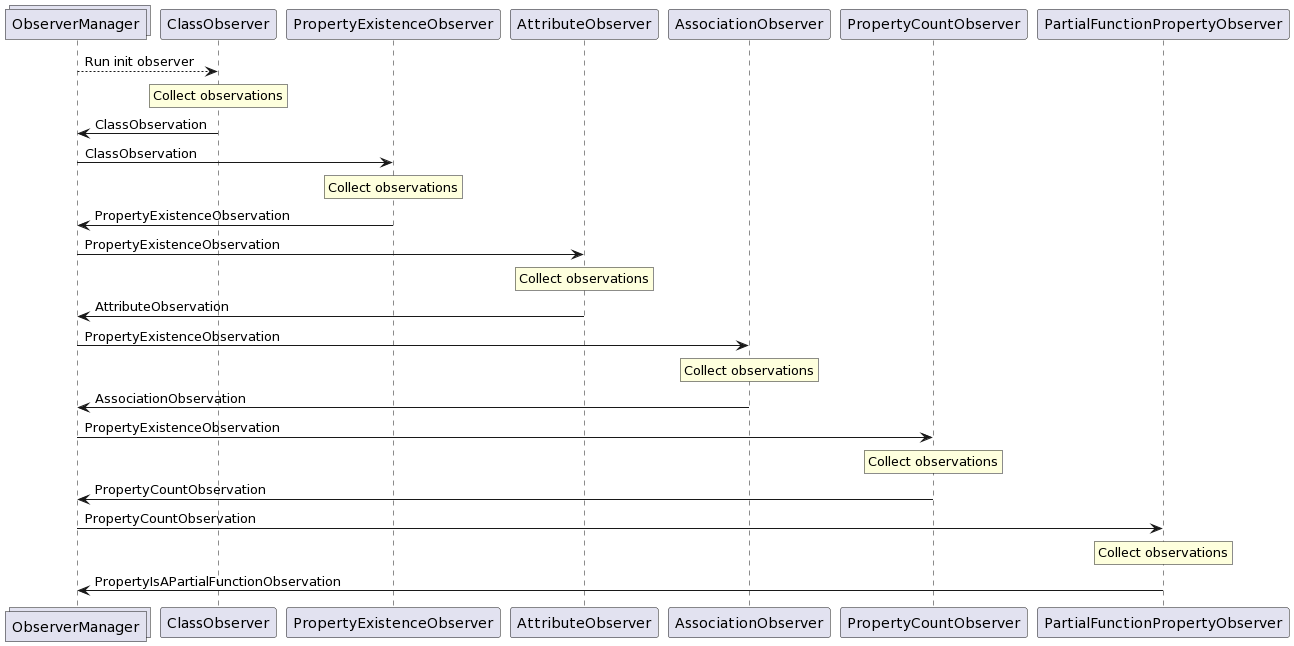Observation
When the application is configured, the user runs the app. Then the application
starts observing the SPARQL endpoint, and collecting observations in the form
of RDF quads (stored in the QueryResult type). These quads are generally
constructed to have a blank node subject representing a single observation,
and its properties then describe that observation.
Ontology
All observations conform to an ontology described in the ontology.ttl file,
which contains a RDFS definition
of the observations in the Turtle format.
Observer system
Observation is essentially just a process where we need to execute many SPARQL queries, where some queries have dependencies on outputs of previous queries. As an example, we cannot observe the existence of properties on some class, before we even know about the class' existence.
Therefore the observation logic is split up into observer classes,
namely EndpointObservers and InitEndpointObservers. These observers
each collect a specific set of observations. EndpointObservers may
declare dependencies on observations produced by other observers.
InitEndpointObservers do not required any previous observations to
do their observations, and they produce the initial observations
which are in turn used by other observers.
The flow of data between observers and their invokation is handled
by the ObserverManager class. It collects the outputs of its
registered observers, and triggers observers which are subscribed
to new observations accordingly.
Its usage looks as follows:
const observerManager = new ObserverManager(config);
observerManager.subscribeInit(new ClassObserver());
observerManager.subscribe(new PropertyObserver());
observerManager.subscribe(new AttributeObserver());
observerManager.subscribe(new AssociationObserver());
observerManager.subscribe(new PropertyCountObserver());
const observations: Observations = await observerManager.runObservers();
Implemented observers
While it is possible for library users to implement and use their own observers, some observers are pre-implemented to facilitate the main flow of SPARQLess.
They each collect a single kind of observation from the ontology:
ClassObserver: collectsClassObservations. These describe the existence of classes and their number of instances in the dataset.PropertyObserver: collectsPropertyExistenceObservations. These describe the existence of properties on given classes.AttributeObserver: collectsAttributeObservations. These describe attributes, i.e. properties whose ranges contain literals (strings, ints, booleans, ...).AssociationObserver: collectsAssociationObservations. These describe associations whose ranges contain other classes.PropertyCountObserver: collectsPropertyCountObservations. These count the number of occurences of a given property in the dataset. This can be useful for users to determine which classes are important in the data.PartialFunctionObserver: collectsPartialFunctionObservations. These describe properties which are guaranteed not to be array-type properties, i.e. properties which are instantiated no more than once for any given class instance.InstanceObserver: collectsInstanceObservations. These describe the existence of class instances. (currently unused)
The data flow between these observers looks like this:

Observation speed
Essential observations for constructing the GraphQL schema are ClassObservation,
PropertyExistenceObservation, AttributeObservation and AssociationObservation.
Other observations are optional, and they just enhance the schema further.
If the fastest startup time is desired, you may want to consider disabling
non-required observations, and configuring hot reloading
to perform these additional observations in the background while
the GraphQL endpoint is already functional.
In fact, the default configuration used by SPARQLessConfigBuilder does
exactly that.
An interesting bit of information about observation query performance is the fact
that in SPARQL endpoints with multiple graphs, adding a GRAPH ?g { ... } clause
around the query body led to significant performance improvements on certain queries.
Namely queries with many class instances across multiple graphs which originally took
tens of minutes now take a few minutes at maximum. While this change did slightly
increase execution times for other queries, the total observation time for
endpoints with mulitple graphs has improved dramatically.